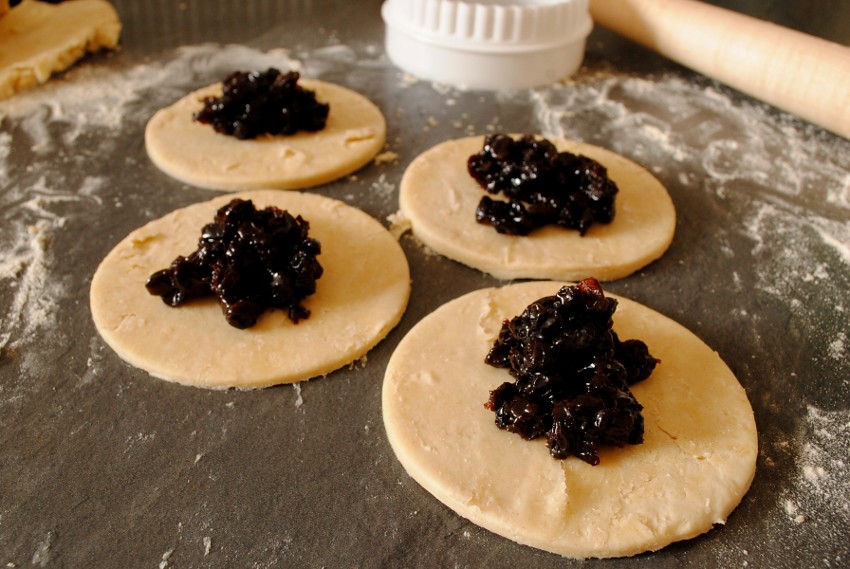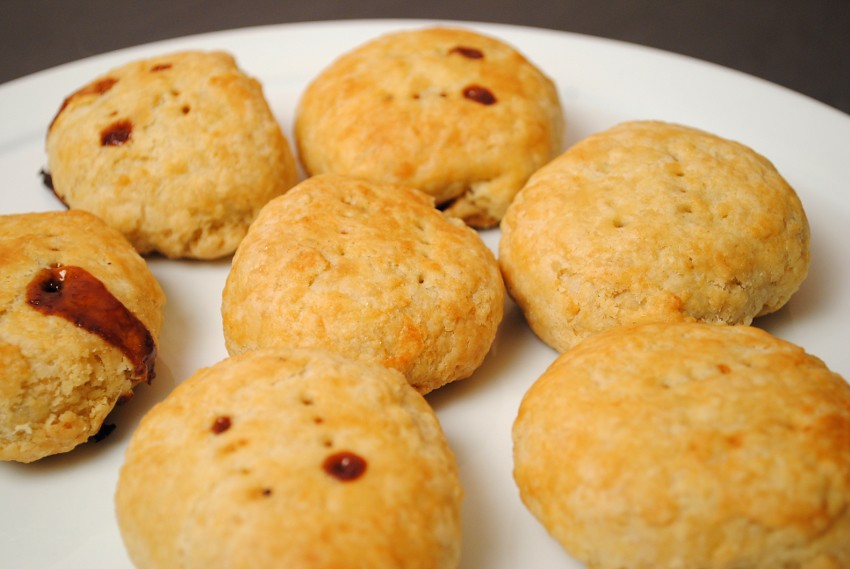Reckless Eccles
Named after the town of Eccles, a few miles west of Manchester, Eccles cakes are thought to date back to the late 18th century when a gentleman by the name of James Birch began selling them to an enthusiastic public. Patties made from flaky pastry wrapped around a sticky filling of spiced currants, Eccles cakes are very similar to the Banbury cakes of Oxfordshire as they are today. Banbury cakes have a longer documented history 1, one well-known early recipe being found in Gervase Markham’s Countrey Contentments, or The English Huswife of 1623, a work that helpfully outlines “The inward and outward Vertues which ought to be in a compleate Woman.” Whatever the striving ‘compleate Women’ of the 17th century might have made of his efforts, it is clear that early Banbury cake recipes are quite different to the later Eccles cake. Banburys were originally yeast-leavened (using barm), and the lack of clarity of old recipes makes it uncertain as to whether the end result was more like a pastry or a bread. On this evidence, it seems to me that Banburys evolved to become more like their northern cousins and cannot claim a longer pedigree in their modern form.
Eccles cakes are one of those things for which many people hold closely guarded secret formulae, but the essential characteristics are simple. The casing is made from puff or flaky pastry with a sugar-glaze, while the filling is made of currants, sugar and butter, with various additions such as orange zest, chopped peel, and spices in various combinations.
I don’t think puff pastry or détrempe 2 works that well with Eccles cakes. In fact, I’m not a great fan of the stuff. There’s a time and place for it, I daresay, but I prefer flaky pastry, which isn’t quite as explosive. In making flaky pastry I’ve found Delia Smith’s method of grating very cold butter into flour works very well and is relatively quick and easy. I also find that many recipes produce a filling that is overbearingly sweet and greasy. Subsequently, I’ve tried to tame tradition by reducing the fat and sugar content.
First, the pastry.
500g plain flour
300g butter, chilled in the freezer for an hour or so
A pinch of salt
Water
Sieve the flour into a mixing bowl and add the salt. Grate the very cold butter into the flour using the coarse side of a hand grater. When I first tried this method I thought I was pretty clever using the grating disc of a food processor. This turned out to be far messier and more time-consuming than just grating it by hand. Add a few tablespoons of water and with a spatula or wooden spoon start bringing the ingredients together. You will need to add more water, but it’s better to add a little at a time, just enough so that the ingredients form a dough. Towards the end you can use your hands, but try to handle it as little as possible. To acheive the flakiness you want, the strands of grated butter should remain reasonably intact – squishing the pastry with warm hands will tend to blend it into the dough. On the other hand, don’t be afraid of it. Making pastry isn’t nearly as difficult as some people make out.
Once the pastry is done, wrap it in clingfilm and put it in the fridge for at least 30 minutes. Now you can make the filling.
220g currants
70ml orange juice or brandy
40g soft brown sugar
A nugget of butter – about 10g if you must measure
1 tsp grated nutmeg
1 tsp allspice
Put the currants in a flat-bottomed bowl or container and pour over the orange juice or brandy. You could experiment with different liquors, but I’ve tried these and I think they work well. Crush the fruit down with the bottom of a glass so that they are more or less covered. Leave to soak for at least a couple of hours, preferably overnight.
Now transfer the fruit to a small pan, along with the sugar, butter and spices. If you’re using orange juice, drain some of it off; you can leave the brandy in as it will evaporate more quickly. Heat the mixture on medium until the butter and sugar has melted and the liquid has reduced and become sticky. Be careful not to let it burn. Now transfer to a bowl and leave until cool.
To assemble the Eccles cakes, roll out the pastry to a thickness of about 5mm on a well-floured worksurface. Using a plain round cutter about 9cm in width, stamp out circles. This recipe will make about 12 cakes. Leftover pastry freezes well. You’ll find a use for it. Place a tablespoon of the fruit filling in the centre of each disc. It’s very sticky, so you will probably need a second spoon to scrape it off. Now the fun part: gather up the edges of each disc with your fingertips and bring them together, drawing the edges closed over the filling. Squish the pastry together to seal the casing. Place the Eccles cake on the floured worksurface and, with the heel of your hand, press it gently but firmly down to flatten it slightly. Turn it over so that the sealed edges are underneath and place it on a tray lined with baking parchment. Some people cut three slashes in the pastry, but I prick each cake a couple of times with a fork instead. I don’t know why, I just prefer it.
Many recipes involve glazing the cakes with egg white and caster sugar, but I brush them with a little milk and then sprinkle the sugar over. The only benefit of using egg is the slight sheen it gives, hardly worth it in my opinion. Now bake in an oven pre-heated to 200°c for 20-25 minutes, keeping an eye on them to make sure they don’t burn. They should be golden brown when done.
Eccles cakes are best eaten when cold; wait a day if you have enough willpower. I don’t pretend my recipe is in any way authentic or representative of the proud northern tradition of the Eccles cake, but it works for me. Further experimentation is certainly possible – replacing half the currants with dried cherries might complement the brandy-steeped version of the recipe. I just hope the good folk of Eccles will forgive me taking such liberties.
Notes:
- Some online sources claim that Eccles cakes were banned by Cromwell’s Puritan government of 1653-1658, but I haven’t been able to find evidence of any such act, nor any mention of Eccles cakes at such an early date. ↩
- From the French adjective détrempé meaning ‘sodden’. Puff pastry rises because layers of fat folded into the dough melt and release steam during baking which separates and lifts the layers; the pastry is therefore said to be sodden, waterlogged ↩




